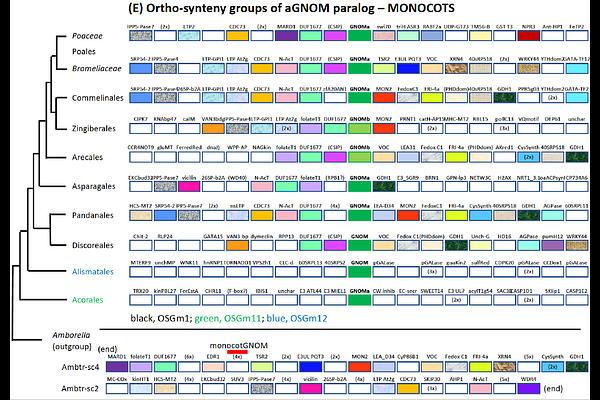Evolutionary origin and functional diversification of plant GBF1-type ARF guanine-nucleotide exchange factors

Evolutionary origin and functional diversification of plant GBF1-type ARF guanine-nucleotide exchange factors
Singh, M. K.; Lauster, T.; Huhn, K.; Richter, S.; Kientz, M.; Neher, R. A.; Juergens, G.
AbstractLarge ARF GTPase-activating guanine-nucleotide exchange factors (ARF-GEFs) are essential regulators of membrane trafficking across the eukaryotes. Although conserved, the GBF1-type ARF-GEFs underwent plant-specific evolution. Of the 3 paralogs in Arabidopsis thaliana, AtGNOM-LIKE1 (AtGNL1) performs the GBF1 task of retrograde Golgi-ER traffic whereas AtGNOM mediates polar recycling from endosomes to the basal plasma membrane. AtGNL2 is specific to pollen and is functionally equivalent to AtGNOM. To clarify their evolutionary origin and functional diversification in the plant lineage, we established a phylogenetic tree and ortho-synteny groups (OSGs), which enabled identification of AtGNOM and AtGNL1 orthologs. In addition, somatic paralogs from several species were functionally analysed in transgenic Arabidopsis plants and tested for GNOM-specific DCB-DCB domain interaction in yeast two-hybrid assays. Our results support the following scenario. The ancient plant-specific GBF1-type ARF-GEF was functionally equivalent to AtGNOM and mediated both polar recycling and secretory trafficking. GNL2 only arose in the early flowering plants and then evolved independently. Genome duplication in the basal eudicots, but neither in monocots nor in magnoliids, gave rise to the AtGNL1 ortholog, distinguished by its unique OSG. The AtGNL1 ortholog lost the ability of DCB-DCB interaction and was free to evolve independently, eventually acquiring AtGNL1 function in the rosid clade of core eudicots. In eudicot evolution, the AtGNOM ortholog underwent repeated transposition to different OSGs whereas the AtGNL1 ortholog was recurrently lost but eventually positively selected. This evolutionary process uncoupled polar recycling required for gravitropic response or lateral root initiation from secretory trafficking required for growth.